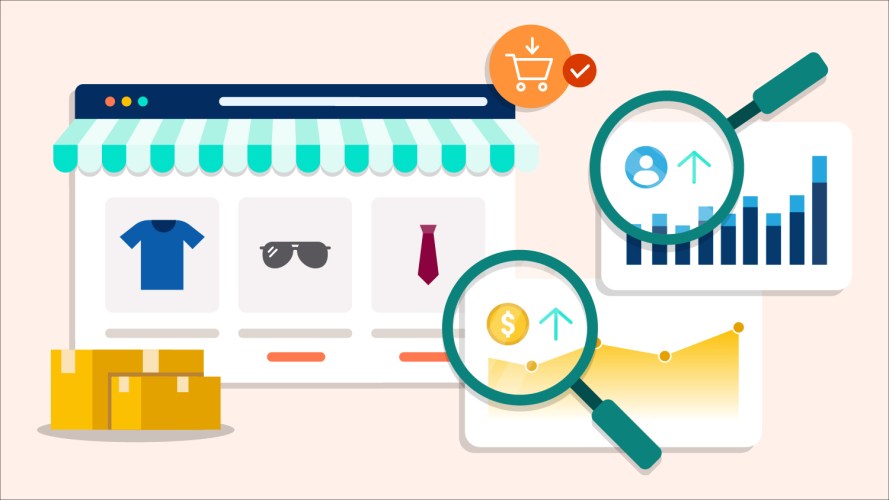Ecommerce SEO: How to Get More Organic Traffic to Your Online Store

More visitors, more sales. Use these key ecommerce SEO tactics to get your products and your business found online.

Lauren Wallace
Imagine you’re in the market for a new washing machine. What’s one of the first things you’d do? If you’re like most global consumers, you’d start your search online. You would likely type a simple phrase (like “front-loading washer”) into a search bar — and your product hunt would begin. The search results that appear after you hit Enter are not random; they’re the outcome of successful ecommerce SEO strategies.
Ecommerce SEO is an art and a science. It involves all the actions you take to improve the visibility of your digital storefront and your products in search engines. Here’s everything you need to know to get your brand and products found online.
What you’ll learn:
What is ecommerce SEO?
How SEO works and why it’s important
The benefits of organic traffic for ecommerce
Five elements of an effective ecommerce SEO strategy
How to use AI to maximize your ecommerce SEO efforts
How do you gauge ecommerce success?
Track these 10 vital metrics to monitor performance.



What is ecommerce SEO?
SEO, also known as search engine optimization, is the practice of optimizing your digital storefront to improve its visibility and rankings in search engine results pages (SERPs). These optimizations include various strategies, from content creation to more technical tasks like site architecture and indexing. The ultimate goals of SEO are to increase organic traffic to your site so you can increase sales.
Ecommerce SEO involves specialized best practices unique to the ecommerce space, including making the most of assets like:
- The ecommerce tech stack
- Ratings and reviews solutions
- Schema markup implementation
- Product data feed optimizations
We caught up with Edwin Romero, an independent SEO consultant with a decade of experience, to get his take. He has played a strategic role in helping small, mid-sized, and enterprise level companies boost their rankings and increase organic traffic. According to Romero, “Ecommerce SEO is vastly different from other arenas in a lot of ways. You have to consider that your target audience wants to make a purchase. You not only have to think about how users find your brand via organic search, you must also consider how to position your business so that users will more easily convert on your website. This is why there are specialized best practices, tactics, and strategies within the ecommerce SEO space.”
How SEO works and why it’s important
Organic traffic is like good word-of-mouth: Although it’s technically “free”, you still need to work for it. Unlike paid media traffic, where every click costs money, organic traffic is earned from the trust of search engines, which will place your pages higher on SERPs if they feel your content is relevant and trustworthy.
Search engines use complex algorithms to determine which pages and websites should be ranked higher in search results. Another challenge? These algorithms change over time, making SEO success a moving target. Ecommerce SEO involves continually optimizing your content, structure, and technical aspects to align with these algorithms. This includes conducting keyword research, optimizing product descriptions and meta tags, improving website speed and performance, building high-quality backlinks, and more.
Over time, organic traffic can provide you with a steady stream of visitors and offset your paid media costs. You can then use more of your paid media budget to focus on your remarketing efforts and customer retention strategy.
The benefits of organic traffic for ecommerce
Cost-effective growth: Almost half (49%) of marketers believe organic search is the most profitable channel they use. That’s because organic content is the gift that keeps on giving. Once you create and publish organic content — whether it’s a blog post, article, or an optimized product page — the asset keeps contributing to your ranking success even when you’re not actively working on it. This is in stark contrast to your paid media efforts, which stop bringing in traffic the moment you stop paying.
Increase brand awareness: With ecommerce SEO, you can reach new customers who may have never heard of your brand before.
Reach an intentional audience: The very nature of an online search requires a certain level of intent. Unlike a user running into a paid ad somewhere online, a user that takes the time to type a specific phrase into a search bar is already looking for certain products when they come across your content.
Boost credibility and authority: If your brand consistently shows up at the top of search results for a range of keywords, users are more likely to perceive your business as credible and trustworthy.
Crush competition: Organic traffic can help you literally push out the competition. The higher your rankings are, the lower your competitors’. The first organic result on page 1 of Google has a standard click-through rate of nearly 40%. The second position? Just 19%. That’s why many businesses take a competitive approach to ecommerce SEO, targeting specific keywords and attempting to outrank similar companies in the same industry.
The benefits of ecommerce SEO go beyond the digital realm. For example, 60% of shoppers say they use their mobile devices to research and compare prices or products while they’re in a store. With the right SEO strategy, you can even reach shoppers in your brick-and-mortar stores.
Five elements of an effective ecommerce SEO strategy
Although ecommerce SEO has many moving parts, a good strategy will always include a few specific aspects:
1. Start with keyword research
Keyword research is the foundation of a successful ecommerce SEO strategy. It all starts with understanding the search terms and phrases your target audience uses to find products similar to your own. Here’s where to focus as you navigate the keyword research process:
- Identify your target audience: Determine who your ideal customers are and what they’re searching for online. Create detailed buyer personas to better understand their needs, preferences, and behaviors. Take some advice from Romero: “It’s easy to go after keywords that have high monthly search volume (MSV). But at the core, ecommerce businesses should focus on the needs of the target audience. Properly catering to target audiences enables ecommerce brands to form the right experience to push conversion through the organic search channel. This can be anywhere from page title and meta description optimization to warranty and returns information.”
- Brainstorm potential keywords: Think of all the relevant terms and phrases related to your products or services. Use tools like Google Search Console, Google Trends, or keyword research tools to generate more ideas. As you brainstorm, consider your customers’ needs — and what they may search for — at every phase of their journey. For example, what pain points do your products solve? Can you think of any how-to content ideas that could offer assistance when using your products? These ideas can be turned into blog posts, FAQ pages, and more.
- Analyze search volume and competition: Use keyword research tools to determine the monthly search volume for each keyword and analyze the competition for those terms. This will help you prioritize which keywords to target and how to plan your approach. Pro tip: Focus on keywords with high search volume and low competition.
- Target long-tail keywords: Long-tail keywords are longer, more specific phrases that may be less competitive, but can still generate significant traffic. For example, if you’re a home appliance company you might target the long-tail keyword, “Energy-efficient front-loading washer and dryer set” rather than just the shorter key phrase, “Washing machine.” Consider creating blogs and other educational content to target longer-tail keywords. Although commercial intent may not be the main goal for users who are searching longer-tail phrases, exposure through blogging and how-tos can improve brand awareness over time.
According to Angie Erickson, SEO Senior Analyst at Salesforce, it’s important to have a long-tail keyword strategy. “Although long-tail keywords might have lower search volume, ranking for them makes a big impact for ecommerce sites. These terms tend to have higher conversion rates than more general keywords that are higher in the marketing funnel. For example, someone searching for a long-tail term like ‘women’s black leather combat boots’ is probably closer to making a purchase than someone searching for a broader term like ‘boots’”.
- Use keyword variations: Consider using variations of your target keywords, such as synonyms, plurals, or related terms, to capture more search traffic.
After performing keyword research, you can use the data to inform your approach to product naming, product categorization, and product descriptions, and ecommerce content marketing, amongst other things.
Branded vs. non-branded keywords
Not all keywords are created equal — and it’s important that your ecommerce SEO strategy focuses on two different kinds: branded and non-branded keywords. Each type of keyword serves a specific purpose. Branded keywords are search terms that include the name of your business. These keywords indicate high intent and propensity to buy — and they direct searchers who are already familiar with your brand to your website.
Non-branded keywords are generic search terms that do not include your brand or product name. These keywords are crucial for reaching new customers in the early stages of the buying process; they capture shoppers who are actively researching or exploring options within a product category. By targeting both branded and non-branded keywords in your SEO efforts, you can increase both brand recognition and customer acquisition.
2. Implement on-page SEO tactics
On-page SEO refers to the optimization strategies and techniques implemented directly on your website’s pages to improve ranking in SERPs. When it comes to on-page tactics, it’s hard to overstate the importance of optimizing your product detail and product listing pages.
According to Erickson, “Successful SEO is a cross-functional endeavor. A partnership between SEO and merchandising teams presents a huge opportunity to drive organic traffic. For instance, SEO teams can recommend product listing pages for site merchandisers to build based on keyword research. Similarly, merchandisers can surface new pages and work closely with SEO teams to get them optimized and cross-linked.”
To give these pages ranking power, start by creating unique and informative page titles and meta descriptions for each product page. Page titles are the most important individual HTML ranking factor on a webpage. They should be concise yet compelling, accurately reflecting the content of the page and incorporating relevant keywords.
Meta descriptions should provide a brief overview of the product, enticing users to click through to your website and learn more. These short descriptions play a key role to ensure that a user clicks through to a website from a SERP. Avoid keyword stuffing in both titles and descriptions, as this can negatively affect your rankings and user experience. Remember, the purpose here is to provide accurate information. Be sure to make the meta titles and descriptions unique for each product page to avoid duplicate content issues.
Creating optimized URLs is another important aspect of on-page SEO. URLs should be descriptive and user-friendly, incorporating relevant keywords whenever possible. Opt for straightforward, static URLs (rather than using dynamic parameters or session IDs). For example, instead of using a URL like “product.php?id=123”, use something like “product/front-load-washers”. This will make your URLs more readable and crawlable, improving your search engine rankings and user experience.
Internal linking also plays a crucial role in on-page SEO. By strategically linking to other relevant pages within your website, you can make it easier for search engines to understand the structure and content of your site. Use descriptive and keyword-rich anchor text when linking between pages to improve your rankings for relevant search terms.
3. Focus on content marketing
Content marketing is the digital face of your brand; it shapes how your target audience perceives and interacts with your business. It’s also a great way to showcase your expertise, educate your customers, and establish yourself as a reliable source of information within your industry (all things that search engines use to determine organic rankings).
Search engines favor authoritative and regularly updated websites, making it essential to maintain a steady flow of fresh content. Although it can be tempting to simply focus on product pages and the content shoppers see right before they make a purchase, there are other parts of the buyer journey that require quality marketing content. By incorporating relevant keywords and phrases into content assets like blog posts, how-to guides, and FAQ pages, you can improve your visibility and reach, making it easier for customers to find your products and services when searching online.
Consider all the questions your shoppers might have as they first learn about your market, brand, and products. If you’re a home appliance retailer, a blog article that answers the question “What are the benefits of a front-load washing machine?” is a surefire way to attract new potential customers who are researching their first major appliance purchase. You can also post helpful blogs and videos that detail instructions for installation and maintenance. The same strategy can be applied to any industry, from hobbies like cooking and home renovations to niche business-to-business (B2B) topics like “How do I calculate my manufacturing costs?”
Make every word on your product pages count
Learn how to write ecommerce content that converts.



4. Pay attention to technical SEO
Technical SEO focuses on (you guessed it!) the more technical aspects of your site, like site mapping, architecture, tagging, and more. Here are a few considerations to keep in mind as you implement your technical SEO strategy:
Site mapping involves planning the structure of all your website’s pages that you want search engines to index and rank. It’s like giving search engines a clear roadmap to navigate through your pages and understand all of your content. This includes not only product pages but also category pages, blog posts, and any other relevant content. A well-structured sitemap ensures that search engines can easily crawl your site to earn high organic rankings.
Site architecture refers to the overall organization and design of a website. This is different from site mapping: Site architecture refers to the underlying framework of your website, including how pages are interconnected and how your content is organized and presented to users. Thoughtful site architecture enhances user experience by making it easy for visitors to find the information they need quickly and efficiently. Similar to site mapping, it also facilitates search engine crawling and indexing, making it easier for bots to understand the context and relevance of each page based on its placement within the site architecture.
Tagging plays a crucial role in categorizing and organizing content on your website. By using relevant keywords and descriptive tags, businesses can help search engines understand the content of each page and associate it with related searches. Title tags signal the main purpose and overall theme of a page, meta descriptions provide a brief summary of what the user will find on a given page, and header tags help prioritize the details of a page. Tagging improves your website’s discoverability and increases your chances of appearing in relevant search results. Properly tagging pages, images, and products allows search engines to index them accurately and provide more precise and relevant results to users.
Canonical tags are also an important element of ecommerce SEO. These tags help search engines understand and prioritize pages when the content is similar (for example, when you have multiple pages dedicated to different types of washing machines). Canonical tags prevent duplicate content issues and ensure that the desired page receives proper credit and ranking authority from search engines.
Robots.txt files tell search engines where they can and cannot go on a website. Because e-commerce websites are large and URLs can include parameters, search engines may inadvertently devote precious resources getting to pages that won’t perform well. A robots.txt file ensures search engines get to the right content quickly.
Schema Markups allow ecommerce websites to provide further context around specific pages and content through specialized coding. For example, ecommerce websites have additional schema markup that can be added to product detail pages that provide valuable insight into a product, including its name, price, and ratings and reviews.
5. Ensure fast load times and site speed
Web pages that take between 1–2 seconds to load have the best ecommerce conversion rates. Site speed is good for business and it’s good for SEO. Search engine algorithms are known to heavily emphasize site speed, making it a critical ranking factor.
Many factors play into pages load times, but there are a few key measures you can implement to improve site speed.
- Optimize image sizes. Large, uncompressed images can significantly slow down page load times. Compressing images without compromising their visual quality can make a substantial difference. Additionally, implementing “lazy loading” for images can further improve perceived page speed by only loading images as users scroll down the page.
- Leverage browser caching. By storing frequently accessed resources (such as images, CSS, and JavaScript files) in a browser’s cache, page loads can be significantly accelerated. According to Romero, this is crucial: “Several ecommerce sites I’ve worked with are plagued by heavy CSS and JavaScript files, which slow down the rendering process and site experience. A way around this is to understand what resources are critical in presenting an optimal user experience and either consolidating, removing, or deferring unnecessary CSS or JS code.”
- Avoid redirects. Redirects add an additional step to the page loading process and they can increase page load times. Consider consolidating multiple redirects into a single one, or eliminating unnecessary redirects to help enhance page speed.
- Choose a reliable hosting provider. Much of your uptime and site speed depends on your hosting provider — the company that owns and operates the servers, data centers, and other infrastructure that make it possible to host your site online. Choosing a trusted, reliable hosting provider is vital when it comes to site speed, user experience, and ecommerce SEO.
How to use AI to maximize your ecommerce SEO efforts
Commerce and marketing teams are already leveraging AI-driven tools to enhance their SEO strategies, optimize website performance, and gain actionable insights. One of the key benefits of AI in SEO is its ability to analyze vast amounts of data and quickly identify patterns and trends. For example, an AI-driven platform can uncover behavioral and purchasing trends of customers who arrive at your site after clicking an organic result for specific keywords.
AI tools can assess website traffic, user behavior, and keyword performance to provide valuable insights for improving SEO strategies and driving organic growth. AI can also significantly speed up content creation, from image generation to long-form written content (like blogs) to product descriptions. According to Romero, “AI can help ecommerce brands build out supplemental content in locations like the product landing page. This content can be programmatically built with keyword targets to help users understand product offerings and make a decision about where to transact.” This helps streamline your SEO efforts, reduce tedious tasks, and maximize the impact of their SEO strategies.
Ready to tackle ecommerce SEO? Start here
Remember, ecommerce SEO is a journey, not a destination. By staying consistent and implementing these best practices, you’ll put your business in a position to grow awareness, rank better, and sell more.
Search engine algorithms change often — which means it’s crucial to stay on top of new updates and make sure your site reflects any important new standards for search. The best place to start? Invest in a connected ecommerce platform that allows you to make changes to your storefront easily and quickly.
Get insights for your business in the era of AI
Here’s how 2,700 commerce leaders are navigating a changing market.












